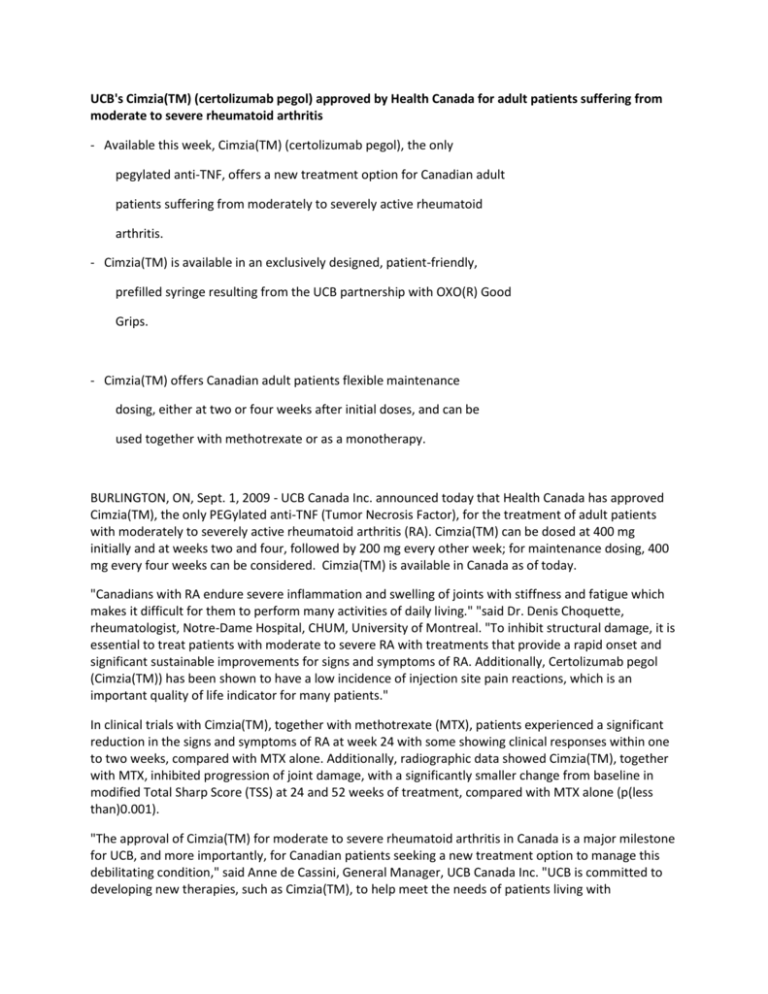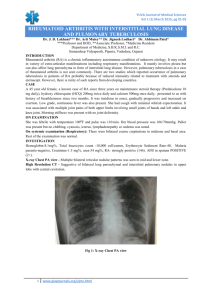UCB`s Cimzia(TM) (certolizumab pegol) approved by Health
advertisement

UCB's Cimzia(TM) (certolizumab pegol) approved by Health Canada for adult patients suffering from moderate to severe rheumatoid arthritis - Available this week, Cimzia(TM) (certolizumab pegol), the only pegylated anti-TNF, offers a new treatment option for Canadian adult patients suffering from moderately to severely active rheumatoid arthritis. - Cimzia(TM) is available in an exclusively designed, patient-friendly, prefilled syringe resulting from the UCB partnership with OXO(R) Good Grips. - Cimzia(TM) offers Canadian adult patients flexible maintenance dosing, either at two or four weeks after initial doses, and can be used together with methotrexate or as a monotherapy. BURLINGTON, ON, Sept. 1, 2009 - UCB Canada Inc. announced today that Health Canada has approved Cimzia(TM), the only PEGylated anti-TNF (Tumor Necrosis Factor), for the treatment of adult patients with moderately to severely active rheumatoid arthritis (RA). Cimzia(TM) can be dosed at 400 mg initially and at weeks two and four, followed by 200 mg every other week; for maintenance dosing, 400 mg every four weeks can be considered. Cimzia(TM) is available in Canada as of today. "Canadians with RA endure severe inflammation and swelling of joints with stiffness and fatigue which makes it difficult for them to perform many activities of daily living." "said Dr. Denis Choquette, rheumatologist, Notre-Dame Hospital, CHUM, University of Montreal. "To inhibit structural damage, it is essential to treat patients with moderate to severe RA with treatments that provide a rapid onset and significant sustainable improvements for signs and symptoms of RA. Additionally, Certolizumab pegol (Cimzia(TM)) has been shown to have a low incidence of injection site pain reactions, which is an important quality of life indicator for many patients." In clinical trials with Cimzia(TM), together with methotrexate (MTX), patients experienced a significant reduction in the signs and symptoms of RA at week 24 with some showing clinical responses within one to two weeks, compared with MTX alone. Additionally, radiographic data showed Cimzia(TM), together with MTX, inhibited progression of joint damage, with a significantly smaller change from baseline in modified Total Sharp Score (TSS) at 24 and 52 weeks of treatment, compared with MTX alone (p(less than)0.001). "The approval of Cimzia(TM) for moderate to severe rheumatoid arthritis in Canada is a major milestone for UCB, and more importantly, for Canadian patients seeking a new treatment option to manage this debilitating condition," said Anne de Cassini, General Manager, UCB Canada Inc. "UCB is committed to developing new therapies, such as Cimzia(TM), to help meet the needs of patients living with rheumatoid arthritis and other immune diseases. UCB is also proud of its partnership with OXO(R) Good Grips and of the fact that RA patients were directly involved in the design and development of our new prefilled syringe, which is designed to make self-administration easy for people living with rheumatoid arthritis." "Rheumatoid arthritis is a complex chronic condition, and it is a good day for the 300,000 Canadians affected by this disease when there are new treatment options made available to them." said Steven McNair, Chief Executive Officer & President of The Arthritis Society. The Health Canada approval was based on UCB's comprehensive clinical program, including data from four multi-center placebo-controlled phase III trials, involving more than 2 300 patients with RA and over 4 000 patient-years experience. Cimzia(TM) has been studied at dosing intervals of two or four weeks, and administered together with MTX or as monotherapy. In the pivotal clinical trials, reported serious adverse reactions were infections including tuberculosis and malignancies including lymphoma. The most commonly occurring adverse events were upper respiratory tract infections, rash and urinary tract infections. A pooled analysis of the safety data show there was a low incidence of injection site pain ((less than)2%) and a low level of discontinuations due to adverse events (5%). It is estimated that 5 million people suffer from RA globally. Approximately one per cent of Canadians of all ages are currently affected by RA(1). Prevalence is not split evenly between genders, since women are three times more likely to be affected than men. Although RA can affect people of all ages, the onset of the disease usually occurs between 35-55 years of age.Regional Physicians available to conduct media interviews: Quebec - Dr. Denis Choquette, Montreal Ontario - Dr. Janet Pope, London Western Canada - Dr. John Esdaile, Vancouver Atlantic Canada - Dr. Majed Khaishi, St. John's ------------------------(1) Statistics CanadaNotes to the editor: About Cimzia(TM) Cimzia(TM) is the only PEGylated anti-TNF (Tumor Necrosis Factor). Cimzia(TM) has a high affinity for human TNF-alpha, selectively neutralizing the pathophysiological effects of TNF-alpha. Over the past decade, TNF-alpha has emerged as a major target of basic research and clinical investigation. This cytokine plays a key role in mediating pathological inflammation, and excess TNF-alpha production has been directly implicated in a wide variety of diseases. In Canada, Cimzia(TM) is approved in combination with methotrexate for reducing signs and symptoms, inducing major clinical response, and reducing the progression of joint damage as assessed by X-ray, in adult patients with moderately to severely active rheumatoid arthritis (RA). Cimzia(TM) may also be used alone for reducing signs and symptoms in adult patients with moderately to severely active rheumatoid arthritis (RA) who do not tolerate MTX. Cimzia(TM) is a trademark of the UCB Group of Companies OXO and GOOD GRIPS are trademarks of Helen of Troy Limited (NASDAQ HELE) and are used under license. IMPORTANT SAFETY INFORMATION Serious infections, sepsis, tuberculosis (including miliary, disseminated and extrapulmonary disease), invasive fungal infections (such as histoplasmosis) and other opportunistic infections, some of which have been fatal, have been reported in patients receiving TNF blocking agents including Cimzia(TM). Many of the serious infections reported have occurred in patients on concomitant immunosuppressive therapy that, in addition to their rheumatoid arthritis, could predispose them to infections. Cimzia(TM) should not be given to patients with a clinically important infection, including chronic or localized infections. Physicians should exercise caution when considering the use of Cimzia(TM) in patients with a history of recurring infection. Patients should be monitored for signs and symptoms of infection while on and after treatment with Cimzia(TM). Any new infection that develops while on Cimzia(TM), or after recent treatment, should be closely monitored. Cimzia(TM) should be discontinued if a patient develops a serious infection. Serious and sometimes fatal infection due to bacterial, mycobacterial, invasive fungal, viral, or other opportunistic pathogens has been reported in patients receiving TNF blocking agents. Among opportunistic infections, tuberculosis (TB), histoplasmosis, aspergillosis, candidiasis, coccidioidomycosis, listeriosis, and pneumocystosis were the most common. Treatment with Cimzia(TM) should not be initiated in patients with an active infection, including clinically important localized infections. The risks and benefits of treatment should be considered prior to initiating therapy in patients with chronic or recurrent infection, who have been exposed to tuberculosis, who have resided or traveled in areas of endemic tuberculosis or endemic mycoses, such as histoplasmosis, coccidioidomycosis, or blastomycosis, or with underlying conditions that may predispose them to infection. Before initiation of therapy with Cimzia(TM), all patients must be evaluated for both active and inactive (latent) tuberculosis infection. If active tuberculosis is diagnosed, Cimzia(TM) therapy must not be initiated. If latent tuberculosis is diagnosed or suspected, appropriate anti-tuberculosis prophylaxis should be instituted in accordance with the current Canadian Tuberculosis Standards guidelines before starting treatment with Cimzia(TM). In this situation, the benefit/risk balance of therapy with Cimzia(TM) should be very carefully considered. Cimzia(TM) should be discontinued if a patient develops a serious infection or sepsis. A patient who develops a new infection during treatment with Cimzia(TM) should be closely monitored, undergo a prompt and complete diagnostic workup appropriate for an immunocompromised patient, and appropriate antimicrobial therapy should be initiated. For patients who reside or travel in regions where mycoses are endemic, invasive fungal infection should be suspected if they develop a serious systemic illness. Appropriate empiric antifungal therapy should be considered while a diagnostic workup is being performed. In clinical studies with Cimzia(TM) and other TNF blocking agents, more cases of malignancies have been observed among patients receiving active drug than in placebo patients. In rheumatoid arthritis placebocontrolled and open-label studies combined, most observed malignancies included lung, breast and ovarian cancers, basal cell carcinoma, and lymphoma. Three cases of lymphoma were reported in patients treated with Cimzia(TM) (1 case in the placebo-controlled studies and 2 in the open-label studies), corresponding to a rate of 0.09 (0.02-0.27)/100 patient-years among 2367 patients. This is approximately 2-fold higher than expected in the general population. Patients with RA, particularly those with highly active disease, are at a higher risk for the development of lymphoma. Malignancies other than lymphomas and non-melanoma skin cancers were observed at a rate (95% confidence interval) of 0.61 (0.37-0.94)/100 patient-years among 2367 Cimzia(TM) -treated patients and 0.41 (0.012.27)/100 patient-years among 647 placebo-treated patients. The size of the control groups and limited duration of the controlled portions of the studies preclude the ability to draw firm conclusions but the possible risk for the development of lymphomas or other malignancies in patients treated with a TNF blocker cannot be excluded. The potential role of TNF blocking therapy in the development of malignancies is not known. Cases of worsening congestive heart failure (CHF) and new onset CHF have been reported with TNF blockers. Cimzia(TM) has not been formally studied in patients with CHF. Exercise caution in patients with heart failure and monitor them carefully. Use of TNF blockers, including Cimzia(TM), may increase the risk of reactivation of hepatitis B virus (HBV) in patients who are chronic carriers of this virus. In some instances, HBV reactivation occurring in conjunction with TNF blocker therapy has been fatal. Patients at risk for HBV infection should be evaluated for prior evidence of HBV infection before initiating Cimzia(TM) therapy. Prescribers should exercise caution in prescribing TNF blockers for patients identified as carriers of HBV. Patients who are carriers of HBV and require treatment with TNF blockers should be closely monitored for clinical and laboratory signs of active HBV infection throughout therapy and for several months following termination of therapy. In patients who develop HBV reactivation, Cimzia(TM) should be stopped and effective anti-viral therapy with appropriate supportive treatment should be initiated. Rare reports of pancytopenia, including aplastic anemia, have been reported with TNF blocking agents. Adverse events of the hematologic system, including medically significant cytopenia (e.g., leukopenia, pancytopenia, thrombocytopenia) have been infrequently reported with Cimzia(TM). The causal relationship of these reports to Cimzia(TM) remains unclear. All patients should be advised to seek immediate medical attention if they develop signs and symptoms suggestive of blood dyscrasias or infection (e.g., persistent fever, bruising, bleeding, pallor) while on Cimzia(TM). Discontinuation of Cimzia(TM) therapy should be considered in patients with confirmed significant hematologic abnormalities. Use of TNF blocking agents has been associated with rare cases of new onset or exacerbation of clinical symptoms and/or radiographic evidence of demyelinating disease. Prescribers should exercise caution in considering the use of Cimzia(TM) in patients with pre-existing or recent-onset central nervous system demyelinating disorders. Neurological disorders, including seizure disorder, optic neuritis, and peripheral neuropathy have been reported in patients treated with Cimzia(TM). Causal relationship to Cimzia(TM) remains unclear. An increased risk of serious infections has been seen in clinical studies of other TNF blocking agents used in combination with anakinra or abatacept, with no added benefit. Because of the nature of the adverse events seen with this combination therapy, similar toxicities may also result from the combination of Cimzia(TM) and other biologic disease modifying anti-rheumatic drugs (DMARDs). Therefore, the use of Cimzia(TM) in combination with other biologic DMARDs is not recommended. The following symptoms that could be compatible with hypersensitivity reactions have been reported rarely following Cimzia(TM) administration to patients: angioedema, dyspnea, hypotension, rash, serum sickness, and urticaria. If such reactions occur, discontinue further administration of Cimzia(TM) and institute appropriate therapy. Treatment with Cimzia(TM) may result in the formation of autoantibodies. If a patient develops symptoms suggestive of a lupus-like syndrome following treatment with Cimzia(TM), treatment should be discontinued. Live vaccines should not be administered concurrently with Cimzia(TM). Interference with certain coagulation assays has been detected in patients treated with Cimzia(TM). Cimzia(TM) may cause erroneously elevated activated partial thromboplastin time (aPTT) assay results in patients without coagulation abnormalities. There is no evidence that Cimzia(TM) therapy has an effect on in vivo coagulation. The most commonly occurring adverse reactions, reported in a greater percentage of Cimzia(TM) treated patients in all placebo-controlled trials (difference (greater than or equal to)2%) were upper respiratory tract infections (17.6% for Cimzia(TM), 9.4% for placebo), lower respiratory tract and lung infections (5.6% for Cimzia(TM), 3.4% for placebo), musculoskeletal and connective tissue signs and symptoms (6.7% for Cimzia(TM), 4.2% for placebo), herpes viral infections (3.6% for Cimzia(TM), 1.2% for placebo), rashes, eruptions and exanthems (4.0% for Cimzia(TM), 1.3% for placebo), and vascular hypertensive disorders (5.1% for Cimzia(TM), 1.2% for placebo). The percentage of patients who discontinued treatment due to adverse reactions during the phase III RA placebo-controlled studies were 5% for Cimzia(TM) -treated patients and 2.5% for placebo-treated patients. About UCB Canada Inc. UCB Canada Inc. was officially incorporated in 2006 with the objective of bringing new-generation therapies to the Canadian market for auto-immune and central nervous system diseases. As a patientfocused organization, the company is dedicated to bringing new and innovative programs to patients, and to the specialists who treat them, to help improve the lives of people living with severe diseases. About UCB UCB, Brussels, Belgium (www.ucb.com) is a biopharmaceutical company dedicated to the research, development and commercialization of innovative medicines with a focus on the fields of central nervous system and immunology disorders. Employing approximately 10 000 people in over 40 countries, UCB generated revenue of EUR 3.6 billion in 2008. UCB is listed on Euronext Brussels (symbol: UCB). Forward-looking statements This press release contains forward-looking statements based on current plans, estimates and beliefs of management. Such statements are subject to risks and uncertainties that may cause actual results to be materially different from those that may be implied by such forward-looking statements contained in this press release. Important factors that could result in such differences include: changes in general economic, business and competitive conditions, effects of future judicial decisions, changes in regulation, exchange rate fluctuations and hiring and retention of its employees. For further information: Sean Webster, Director, Market Access and Government Relations, UCB Canada Inc., T: (905) 315-5065 ext 5073, sean.webster@ucb.com; Eric Miller, Corporate Communications & Public Relations, UCB, T (770) 970-8569, eric.miller@ucb.com






